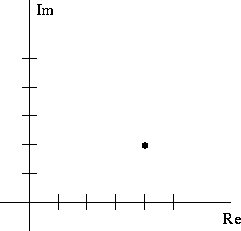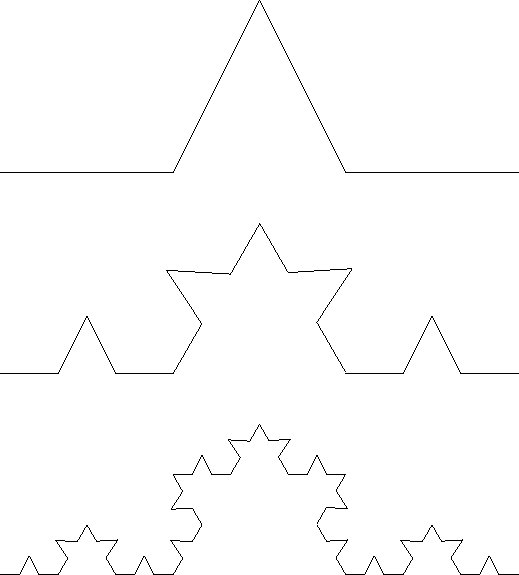Fractals
Tom Kelliher, CS 320
Mar. 11, 1998
Announcements: pong due Friday.
From last time:
- Pong
Outline:
- Preliminaries.
- Fractals.
- Julia-Fatou sets.
- Mandelbrot set.
Assignment: Read Section 9.5.
-
 : the ``imaginary'' number.
: the ``imaginary'' number.
- Complex numbers.
- The complex plane.
Representation of  in the complex plane:
in the complex plane:

- Complex addition:

- Complex multiplication:

- Complex magnitude:

(Cartesian distance)
- Fractal: Any object which has a substantial measure of exact or
statistical self-similarity. Precisely speaking, true fractals have
statistical self-similarity at all resolutions.
- Self-similar object: An object which can be translated, rotated,
and scaled onto a sub-portion of itself.
- ``Self-similar'' objects: coasts, mountains, trees, plants.
- von Koch snowflake example:

Scale snowflake by 1/3 and replace each of four ``segments'' with scaled
snowflake.
- Consider the complex sequence:

where  is a point in the complex plane and c is a complex constant.
is a point in the complex plane and c is a complex constant.
- What is the behavior if c=0?
- What can happen with the sequence?
- Be ``attracted'' to a finite value.
- Be attracted to infinity.
- Not be attracted to any value (diverge).
The Julia-Fatou set is this latter set of values.
- Structure of Julia-Fatou sets: some simple, some complex.
- The notion of ``connectivity.''
- The Julia-Fatou set associated with a complex number.
- Definition: The Mandelbrot set consists of those complex numbers
whose associated Julia-Fatou set is ``connected.''
- Consider computing the Mandelbrot set.
- An approximation. Consider the sequence:

where z is a point in the complex plane which we're considering for
inclusion in the Mandelbrot set. Notes:
- Usually run 100--1,000 iterations.
- The point's color is chosen as a function of how many iterations
are completed before
 , where t is a threshold value.
, where t is a threshold value.
- Increasing the number of iterations and/or the threshold improves
the approximation.
- Typical values: 100 iterations, threshold of 2.
Thomas P. Kelliher
Wed Mar 11 09:08:56 EST 1998
Tom Kelliher
 : the ``imaginary'' number.
: the ``imaginary'' number.
 in the complex plane:
in the complex plane:




 : the ``imaginary'' number.
: the ``imaginary'' number.
 in the complex plane:
in the complex plane:






 is a point in the complex plane and c is a complex constant.
is a point in the complex plane and c is a complex constant.

 , where t is a threshold value.
, where t is a threshold value.